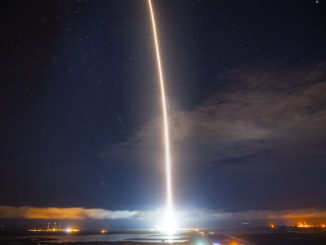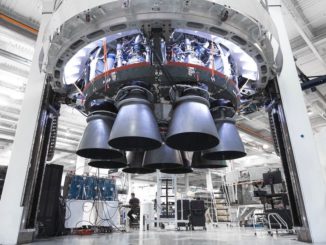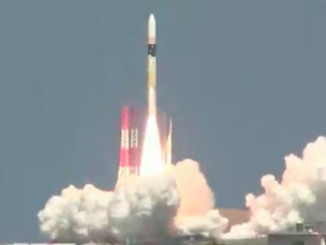
Riding a Japanese rocket, the Arab world’s first interplanetary probe departed planet Earth on Sunday to begin a seven-month journey to Mars on a dual mission of scientific exploration and proving the mettle of the UAE’s growing space program.
Funded and led by the United Arab Emirates, the Mars probe carries a digital camera to image the Martian surface, dust storms and ice clouds, and spectrometers to measure constituents at multiple levels of the planet’s atmosphere.
The science payload will allow researchers to better link Martian weather with longer-term trends of atmospheric loss, the process by which molecules are stripped away from Mars by the solar wind.
“It is a weather satellite, and that’s one objective of the mission,” said Sarah al-Amiri, the Mars mission’s lead scientist and the UAE’s minister of state for advanced sciences, in a pre-launch interview with Spaceflight Now. “We also look at what role Mars’s weather plays in atmospheric loss. That’s the other part of the mission.”
The Emirates Mars Mission — also called Hope, or Al Amal — also carries the UAE’s ambition to become a bigger player in international science, high-tech research and development, and space exploration.
“One of the objectives of this mission is to develop scientific capabilities and develop researchers, and in the long run, develop scientists who are able to work in planetary research, focusing on Mars for now,” al-Amiri told Spaceflight Now.
The Hope probe launched at 5:58:14 p.m. EDT (2158:14 GMT) Sunday from the Tanegashima Space Center in Japan. A Japanese H-2A rocket, built by Mitsubishi Heavy Industries, took off with the nearly 3,000-pound (1,350-kilogram) Hope spacecraft at 6:58 a.m. Japan Standard Time on Monday.
The 174-foot-tall (53-meter) H-2A launcher darted into a sunny sky over Tanegashima and arced toward the east over the Pacific Ocean. The rocket’s core stage engine and twin strap-on solid-fueled boosters combined to push the launcher into the sky with 1.4 million pounds of thrust.
Check out a replay of the H-2A rocket firing into a clear morning sky over the picturesque Tanegashima Space Center in Japan with the UAE’s #HopeMarsMission.
Seconds later, a vapor cone appears around the launcher as it exceeds the speed of sound. https://t.co/xxyCmibQGt pic.twitter.com/1CfHYek8AP
— Spaceflight Now (@SpaceflightNow) July 19, 2020
Less than two minutes later, the H-2A’s solid rocket boosters burned through their pre-packed propellants and jettisoned. The H-2A’s clamshell-like payload fairing separated around four minutes into the mission, followed by shutdown of the rocket’s hydrogen-fueled core stage engine roughly six-and-a-half minutes after liftoff.
The rocket shed its first stage to fall into the Pacific, and the H-2A’s cryogenic upper stage ignited two times to first reach a preliminary low-altitude parking orbit, then to propel the Hope spacecraft to a velocity of some 21,000 mph (34,000 kilometers per hour).
The second upper stage burn gave the Hope probe enough energy to break free of the grip of Earth’s gravity.
The H-2A released the spacecraft about 56 minutes into the mission while flying over the Atlantic Ocean east of Brazil.
A few minutes later, the Hope probe flew in range of a NASA Deep Space Network tracking station near Madrid. After a brief concern that one of the spacecraft’s two solar array wings may not have unfurled, ground controllers at the Mohammed Bin Rashid Space Center in Dubai confirmed both panels had, in fact, deployed.
That news prompted a round of applause in the mission control room in Dubai.
Telemetry data beamed down from Hope indicated the spacecraft’s computer, propulsion and communication systems, and other components were functioning normally.
“The Emirates has successfully launched the first interplanetary mission in the Arab world, commencing a 493-million-kilometer (306-million-mile) journey to Mars,” said Ahmad Al Falasi, the UAE’s minister of state for higher education and chairman of the UAE Space Agency. “This is a huge leap forward for the UAE’s ambitious space program. The Emirates Mars Mission is a catalyst that has already served to significantly accelerate the development of the UAE’s space, education, science and technologies sectors.”

The launch of the UAE’s Hope mission Sunday will be followed by the departures of two more Mars missions later this month. Launch opportunities for Mars missions come every 26 months or so, when Earth and Mars are properly positioned in their orbits around the sun.
China’s Tianwen 1 Mars mission is scheduled for launch as soon as Thursday, July 23, on top of a heavy-lift Long March 5 rocket. Tianwen 1 is China’s first Mars mission, and it includes an orbiter and a rover that will attempt to land on the Red Planet.
NASA’s Perseverance rover will follow with a liftoff from Cape Canaveral scheduled for July 30 aboard a United Launch Alliance Atlas 5 rocket. Perseverance carries a sophisticated suite of science instruments to explore Jezero Crater, where scientists believe water once flowed in an ancient river delta.
Mars has dried up over the last several billion years, but scientists hope to find signs of ancient life in samples collected at Jezero Crater. Perseverance will gather rock core samples for eventual return to Earth by a future robotic mission.
The European Space Agency had planned to launch its ExoMars rover to the Red Planet this month, but ESA delayed the mission to the next Mars launch window in 2022 due to problems with the spacecraft’s parachute.
The UAE’s Hope orbiter, China’s Tianwen 1 mission, and NASA’s Perseverance rover will all arrive at Mars next February.
The UAE government first announced plans for the Emirates Mars Mission –also known as Hope, or Al Amal — in July 2014. The government-funded project was designed, built, tested and readied for launch in less than six years, and on a budget of roughly $200 million, a fraction of the cost of NASA’s Mars orbiters.
The spacecraft and its three scientific payloads were developed as a collaborative project between scientists at the Mohammed Bin Rashid Space Center, the UAE Space Agency, and three universities in the United States.
The spacecraft was assembled by Emirati and U.S. engineers at the Laboratory for Atmospheric and Space Physics at the University of Colorado at Boulder. Scientists from Arizona State University and the University of California, Berkeley, also contributed to developing the mission’s scientific instruments.
“International collaboration, especially in a scientific mission, is critical,” said Omran Sharaf, the Hope mission’s program manager, in a pre-launch interview with Spaceflight Now. “So we have parts that have been developed in the UAE, we have parts that have been developed in the U.S., and have parts that have been developed in Canada, in Spain, in Europe, that are actually within the mission itself.”
The UAE’s government set the nation on a course for a Mars mission by outlining several objectives, including inspiration for Arab youth, revitalizing the UAE’s high-tech sector, introducing a culture for research and development, and aligning the mission’s arrival at Mars with the 50th anniversary of the country’s independence in 2021.
Burj Khalifa celebrates the #FirstArabicCountdown
Watch the launch of the #HopeProbe LIVE https://t.co/mCEo0Nphjv#HopeMarsMission pic.twitter.com/2LYO0bjK1K— Hope Mars Mission (@HopeMarsMission) July 19, 2020
The UAE celebrated the launch of the Hope mission with a colorful display on Burj Khalifa in Dubai, the tallest building in the world.
“The identity of the mission is not just about the UAE, it’s also for the Arab world,” Sharaf said. “It’s supposed to inspire the Arab youth, and send a message of hope to them.”
“Usually, missions that are sent to Mars take a long time and cost more because redundancy is important,” Sharaf said. “In our case, our philosophy was simplicity was important. So instead of crowding our spacecraft with a lot of instruments, we decided to focus on specific questions and address a specific set of questions.”
Emirati engineers worked alongside teams in Colorado to design and build the Hope spacecraft, collaborating and learning from veteran aerospace engineers who have worked on numerous interplanetary missions. In the future, the UAE could pursue more ambitious interplanetary probes, and do more of the work on its own.
The training aspect of the Hope mission is similar to the way Emirati engineers worked with a South Korean company to build the DubaiSat 1 and 2 Earth-imaging satellites, which launched in 2009 and 2013. Using lessons learned from that experience, UAE teams took on more responsibility in building the KhalifaSat Earth observation satellite that launched in 2018.
The UAE’s first astronaut, Hazzaa Ali Almansoori, flew to the International Space Station on a nearly eight-day mission last year.
The country’s burgeoning space program is geared toward helping the UAE foster a “post-oil economy,” Sharaf said.
“So that’s why they went with a Mars shot,” he said. “They wanted to create an ecosystem that supports the creation of an advanced science and technology sector. The other thing that the UAE wanted to do is it wanted to prepare future scientists and engineers in the UAE that eventually would be able to address our national challenges, which are mainly focused around water resources, food resources, and clean energy.”

“The direction for the government was to build it, don’t buy it,” Sharaf said of the Emirates Mars Mission. “Work with others, learn from others, don’t start from scratch. Start where others ended, so complement their work. However, you need to build it, you’re not going to buy it. Obviously, there is going to be risk associated with that, especially since it’s the first mission we’ve built that goes to Mars.”
Pete Withnell, a program manager at LASP who worked on the Emirates Mars Mission, said it was an “ideal choice” for UAE officials to reach out to experts at U.S. research institutes to help develop the Mars orbiter. After all, he said, universities are made to transfer knowledge.
“Perhaps the most visible part of this mission is a spacecraft, and instruments, and a journey to Mars, and an important scientific endeavor to happen there,” Withnell said in a virtual media briefing before the launch. “That’s all inside of this greater purpose of creating the knowledge economy, and creating a program which used knowledge transfer as its driving mechanisms.”
More than 450 people worked on the Emirates Mars Mission, according to Sharaf. About 200 members of the team have come from the UAE, and about 150 people from LASP in Colorado have worked on the project. Of the 200 Emiratis assigned to the mission, more than a third have been women, Sharaf said.
“The very fabric that a university is made out of is one based on education, teaching, mentorship, and indeed, collaboration,” Withnell said. “So these concepts were not only familiar to us, but it was our very nature to participate in this program in the way that the original founders and visionaries of this program required.”
“I would say at the beginning of the program six years ago, there was no blueprint,” Withnell said. “There was no plan that existed how to go about organizing this type of collaboration for a deep space mission.”
With the successful launch behind it, the Hope probe will perform the first in a series of course correction maneuvers in August, beginning a process of fine-tuning the Hope probe’s trajectory toward Mars. Eventually, navigators on Earth will guide the spacecraft toward a precise aimpoint near the Red Planet, comparable to an archer hitting 2-millimeter target from a kilometer away, according to Withnell.
A 30-minute firing by the Hope probe’s engines will steer the spacecraft into orbit around Mars in February, completing the interplanetary journey. The maneuver to enter orbit at Mars is one of the riskiest phases of the mission, Sharaf said.
After swinging into an initial capture orbit next February, the Hope spacecraft will maneuver into an operational science orbit around April 2021 that ranges between approximately 12,400 miles (20,000 kilometers) and 26,700 miles (43,000 kilometers) above Mars.
During parts of each 55-hour semi-synchronous orbit, the spacecraft’s move at roughly the same speed around Mars as the planet’s rotation. That will give the orbiter’s science instruments sustained views of the same region of Mars in much the same way weather satellites in geostationary orbit provide uninterrupted views of the same part of Earth.
The Hope mission will pursue many of the same science objectives as NASA’s Mars Atmosphere and Volatile Evolution, or MAVEN, spacecraft. MAVEN arrived at the Red Planet in 2014.
Scientists have analyzed data from the MAVEN mission to confirm that the bombardment of the solar wind and radiation stripped away the Martian atmosphere, transforming the planet from a warmer, wetter world into the barren planet of today.
The Hope probe will track oxygen and hydrogen escaping from the Martian atmosphere into space, and will peer deeper into the planet’s atmosphere than MAVEN. Scientists want to investigate possible links between Martian weather and climate with the escape of atmospheric particles.
“We focus on three primary objectives,” said Sarah Al Amiri, the lead scientist for the Emirates Mars Mission and the UAE’s minister of state for advanced sciences. “The first is to characterize the weather system of Mars throughout an entire year, and more importantly fill in the gap of the day-to-night transitions within the weather of Mars.
“We also look at how far out hydrogen and oxygen extend into space. That gives us an understanding of how far out it gets, and provides a better understanding of atmospheric escape,” she said.
One of the tasks of the science team will be “linking the two objectives together, characterizing changes within the lower atmosphere, so if there’s a dust storm on Mars, or changes in temperature, how does that impact rates of atmospheric escape, and particularly escape of hydrogen and oxygen from the outer atmosphere.
A color camera on the mission was developed by LASP at the University of Colorado at Boulder and MBRSC. Infrared and ultraviolet spectrometers were produced by LASP, Arizona State University and the University of California, Berkeley, in partnership with Emirati scientists.
NASA Administrator Jim Bridenstine said in June that the UAE’s advancements in space exploration could lay the groundwork for further international cooperation.
“I’m very excited about the United Arab Emirates, and their Hope mission,” Bridenstine said. “We have done a lot to support them, and they want to be big supporters of ours in the Artemis (moon landing) program.
Bridenstine congratulated the UAE on the successful launch Sunday.
“Today marks the culmination of tremendous hard work, focus, and dedication, as well as the beginning of the UAE’s journey to Mars with the ultimate goal of human habitation of the Red Planet,” Bridenstine said in a written statement. “This mission is aptly named since it’s a symbol of inspiration for the UAE, the region, and the world.”
In addition to the help from U.S. universities, which contributed without the direct support from NASA, the U.S. space agency is providing tracking and communications time on the Deep Space Network throughout Hope’s mission to Mars.
“We are in awe of the speed and commitment the UAE, through both the Mohammed bin Rashid Space Center and the UAE Space Agency, has demonstrated in developing its first interplanetary spacecraft,” Bridenstine said. “Moreover, your dedication to advancing the world’s understanding of Mars by publicly sharing the science and data produced by Hope represents the values of unity, peace, and transparency, that will be so important as humanity moves ever farther into the solar system.
“Even during these challenging times, humanity’s spirit of exploration and curiosity remain undeterred,” Bridenstine said. “We’re eager for our own Mars mission, Perseverance, to join Hope on its journey to explore Mars. Much like the UAE and the United States of America here on Earth, our two spacecraft will travel to Mars together to benefit the entire world.”
Email the author.
Follow Stephen Clark on Twitter: @StephenClark1.



